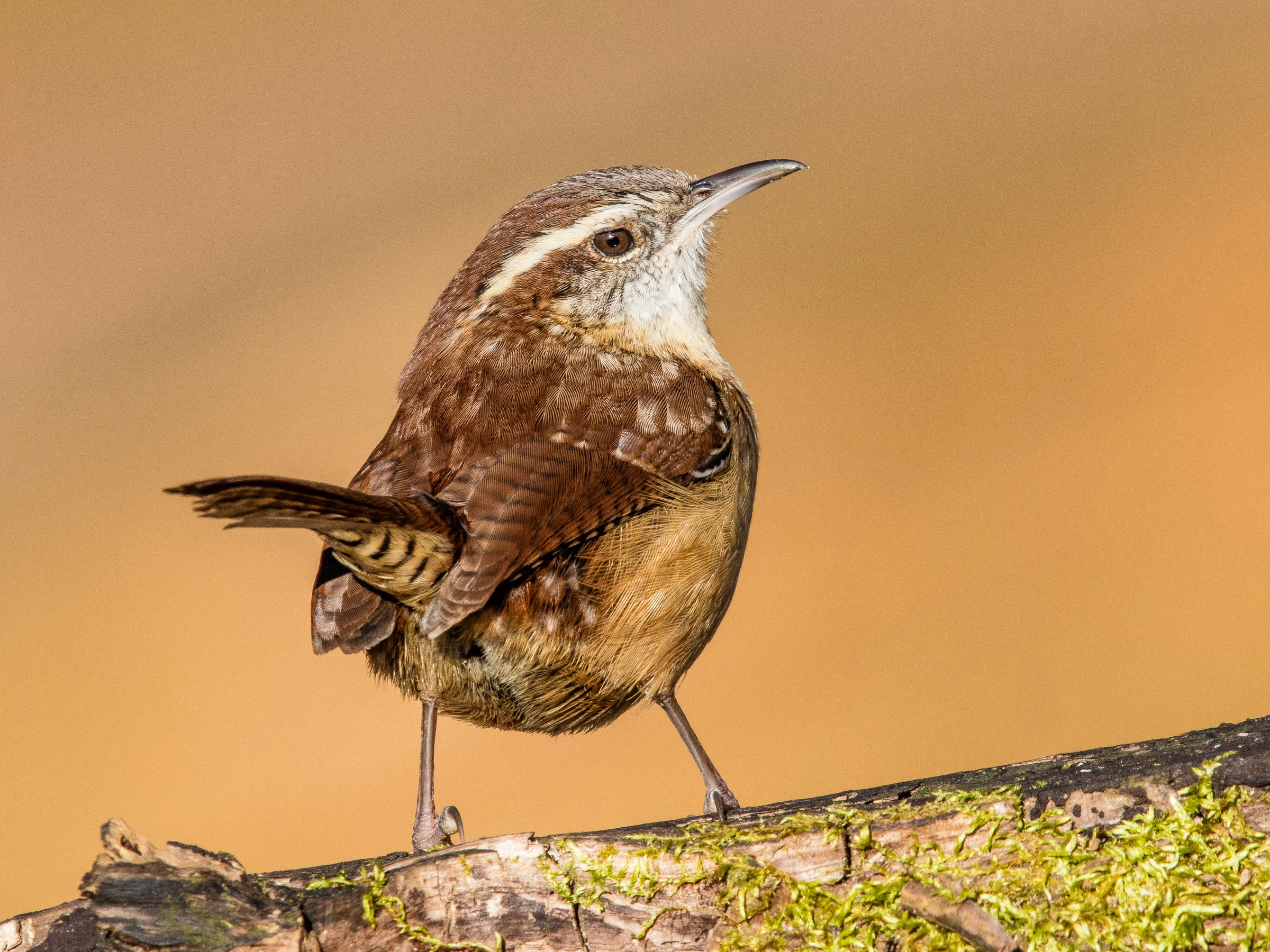Songbirds known as wrens may not catch your eye at first glance, but their lively personalities make them stand out. These birds, typically small and plump with brown feathers, have distinctive upright tails and powerful voices.
Wrens are native to the Americas, with the exception of the Eurasian Wren found in Europe and Africa. They belong to the Troglodyidae family of birds.
In North America, you can find 11 different species of wrens, 10 of which have been spotted in Colorado. Among these, nine species are regularly seen, while one is considered accidental.
Throughout the year, you can observe Marsh Wrens, Canyon Wrens, Bewick’s Wrens, and Cactus Wrens in Colorado.
During the summer, House Wrens and Rock Wrens make appearances in Colorado.
In the winter, you may come across the Winter Wren.
Keep an eye out for other wren species in Colorado, such as Pacific Wrens, Sedge Wrens, and Carolina Wrens.
Wrens have adapted to survive in various environments, including dry and rocky areas with limited vegetation. They owe their resilience to their diet, which primarily consists of insects and spiders.
Previously, it was believed that the Winter Wren was the same species as the Pacific Wren and Eurasian Wren. However, they have now been recognized as separate species.
Over the course of history, wrens have been associated with folklore and symbolism. In Europe, it was once believed that harming wrens would bring bad luck.
To help you identify wren species in Colorado, this guide follows the order provided by avibase and is based on the frequency of sightings reported by birdwatchers on ebird.
For a comprehensive bird identification guide specific to Colorado, you can obtain a free printable version, which will assist you in recognizing many bird species that visit your backyard.
Here are the 10 wren species found in Colorado:
1. House Wren
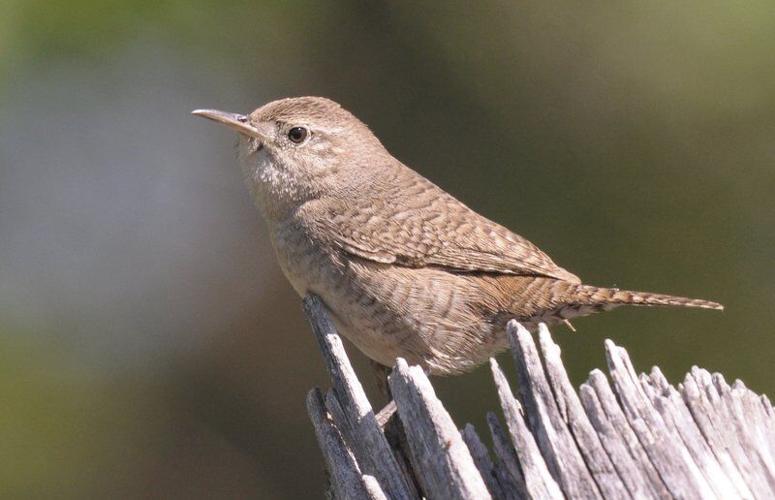
House Wrens can be spotted in Colorado during the breeding season and are reported in 30% of summer checklists submitted by birdwatchers. They are most commonly seen between April and October. While most migrate south for the winter, a few remain in Colorado throughout the year.
House Wrens are small round birds with nondescript brown feathers. The males and females look identical, featuring darker barred wings and tails and a paler throat.
Key characteristics: The eyestripe is less prominent compared to other wren species.
Scientific name: Troglodytes aedon
Length: 4.3-5.1 inches (11-13 cm)
Weight: 0.3-0.4 ounces (10-12 g)
Wingspan: 5.9 inches (15 cm)
During the summer, House Wrens breed in the United States and Southern Canada before migrating to southern regions and Mexico for the winter.
You can find House Wrens in backyards, parks, and open woods, where they actively search for insects and spiders. They can be observed energetically hopping among branches, occasionally stopping to sing their cheerful song.
House Wrens primarily feed on insects and spiders, such as beetles, caterpillars, and flies. They also consume snail shells as a source of calcium.
In terms of their vocalizations, House Wrens lack a melodious tune but instead produce a series of rapid and varied notes in terms of pitch and speed.
Nests of House Wrens are typically located in old woodpecker holes, nest boxes, or other small crevices. They prefer lightly wooded areas and construct their nests using twigs, often lining them with softer materials. The females lay 3-10 eggs, which take around two weeks to hatch. The chicks then take an additional two weeks to fledge.
To attract House Wrens to your backyard, consider creating brush piles or installing nest boxes.
Interesting fact: Despite their small size, House Wrens are known for their fierce nature when it comes to claiming the best nest holes. They may even intimidate larger birds and remove eggs or nestlings from desired nesting sites.
2. Rock Wren
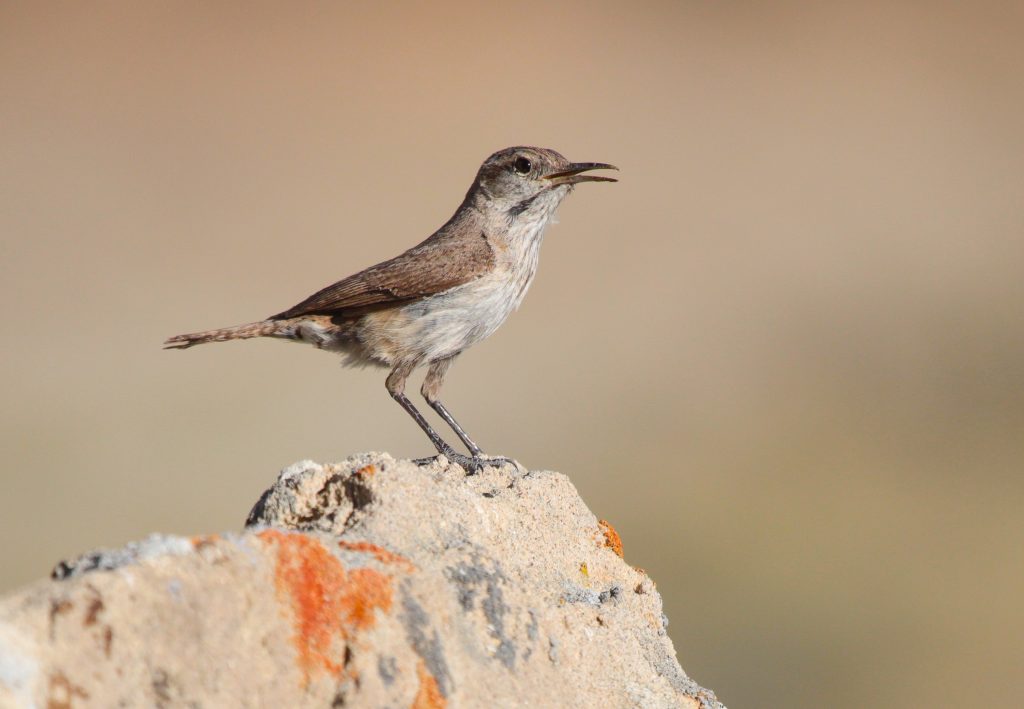
Rock Wrens are reported in 3% of checklists during the summer in Colorado and can be observed from April to October before they migrate south for the winter. However, a few individuals remain in Colorado throughout the year.
Rock Wrens have pale brown backs with dark flecks. They exhibit barring on their wings and tail and have a pale underside with buff coloring on the lower flanks and belly.
Distinctive features: They possess a pale eyebrow stripe, a long slightly curved bill, and dark legs. Both males and females share the same coloring. Rock Wrens are known for bobbing up and down, especially when agitated, which can aid in their identification.
Scientific name: Salpinctes obsoletus
Length: 4.9-5.9 inches (12.5-15 cm)
Weight: 0.5-0.6 ounces (15-18 g)
Wingspan: 8.7-9.4 inches (22-24 cm)
Rock Wrens can be found in dry and rocky areas within western states of the United States and southwestern regions of Canada. While those residing in the south and west remain year-round, individuals in central states of the US migrate south for the winter.
Keep an eye out for Rock Wrens in dry and rocky areas that lack abundant vegetation. They forage for insects hidden within crevices in rocks.
When it comes to their vocalizations, Rock Wrens are known to produce more than 100 songs, often repeating the same sound several times before transitioning to a different sound. Each rendition of their song varies in pitch.
Nests of Rock Wrens are built on the ground, typically within a cavity or depression in rocky areas. They incorporate a layer of small stones followed by softer materials like wool and moss. These wrens can lay up to 8 eggs and produce up to 3 broods per year.
Fascinating fact: Rock Wrens construct pathways made of stones and various objects leading to their nests, although the purpose of these pathways remains unknown. Additionally, these birds do not drink water and obtain all the necessary moisture from their insect diet.
3. Marsh Wren

Marsh Wrens can be observed in Colorado throughout the year, but they are most commonly spotted from March to December.
These birds have brown feathers with black and white streaks on their backs. Their undersides feature a grayish-brown hue, and they possess the characteristic upright tail typical of wrens.
Marsh Wrens lack shoulder stripes and have longer bills compared to Sedge Wrens. Males and females share similar appearances.
Scientific name: Cistothorus palustris
Length: 3.9-5.5 inches (10-14 cm)
Weight: 0.3-0.5 ounces (9-14 g)
Wingspan: 5.9 inches (15 cm)
Marsh Wrens breed in the northern states of the United States and central regions of Canada before migrating to southern states and Mexico. Some individuals residing in the western and Atlantic Coast regions may remain year-round. During migration, they can be observed in the eastern parts of the United States.
To locate Marsh Wrens, search wetlands where they cling to reeds, gripping each foot to different stalks. Spotting them might prove challenging, but their singing among the reeds, particularly during dawn and dusk, can help in their detection.
Marsh Wrens primarily feed on insects and spiders, which they pick off leaves close to the water.
When it comes to their vocalizations, Marsh Wrens produce a distinct buzzing song that can last for up to 20 minutes.
Nests of Marsh Wrens are fully enclosed, except for a small opening at the top. They are woven from reeds and grasses. The females lay 3-10 eggs, which hatch after around two weeks, and the chicks fledge after an additional two weeks.
Fun fact: Marsh Wrens may build up to twenty dummy nests attached to cattails, but they typically use only one nest and destroy the eggs and nestlings of rival birds.
4. Canyon Wren
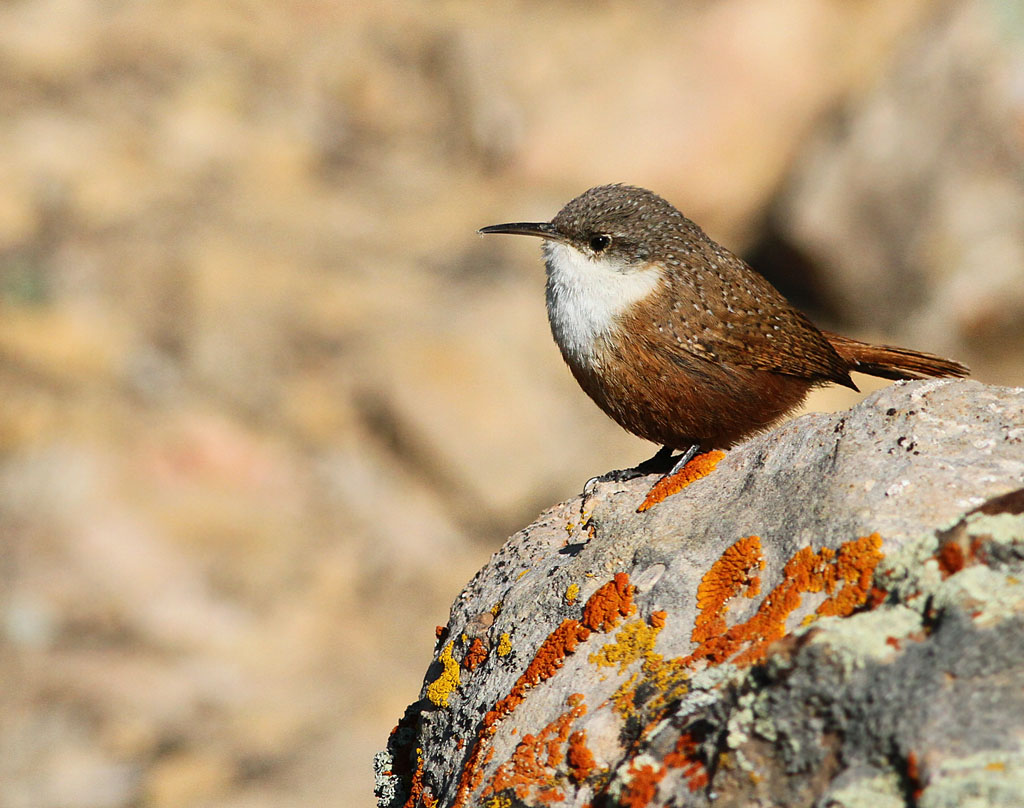
Canyon Wrens are non-migratory residents of Colorado throughout the year.
These birds have stocky brown bodies with white throats and lighter barred tails. Their heads exhibit a grayish-brown coloration with speckles. Canyon Wrens possess short, strong legs, which they use to cling onto rocks. Males and females have identical appearances.
Distinctive features: While they inhabit similar rocky areas as Rock Wrens, Canyon Wrens can be distinguished by their white throat and dark belly.
Scientific name: Catherpes mexicanus
Length: 4.5-6.1 inches (11.4-15.4 cm)
Weight: 0.3-0.7 ounces (9.9-18.3 g)
Wingspan: 7.1-7.9 inches (18-20 cm)
Canyon Wrens can be found in the western regions, ranging from southern British Columbia to western states of the United States and Mexico. They do not migrate.
When searching for Canyon Wrens, explore rocky areas where they forage for insects and spiders concealed within crevices. Their short, sturdy legs enable them to cling to rocks and even scale vertical cliff faces.
Canyon Wrens produce a distinctive song that descends, slows, and concludes with a few raspy notes.
Nests of Canyon Wrens are built within crevices using twigs and grasses, often lined with wool and feathers.
Interesting fact: Canyon Wrens steal food from spider webs and wasp nests.
5. Bewick’s Wren
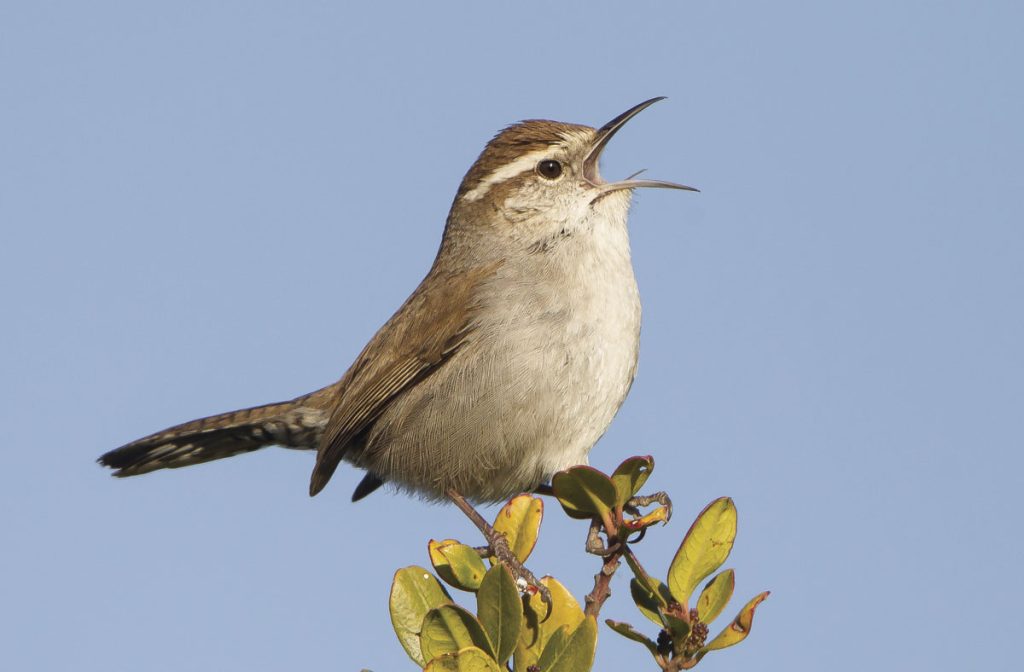
Bewick’s Wrens can be observed in Colorado throughout the year, but they are most commonly spotted in May, accounting for 1% of checklists during this time.
These wrens possess brown backs with long, gray, upright tails featuring darker barring. They exhibit gray bellies and a white stripe over the eye.
Scientific name: Thryomanes bewickii
Length: 5.1 inches (13 cm)
Weight: 0.3-0.4 ounces (8-12 g)
Bewick’s Wrens reside in southern and western states throughout the year, with some small movements during winter.
To locate Bewick’s Wrens, explore scrublands, thickets, and open woodlands. These wrens can be observed hopping from branch to branch, flicking their long tails.
Bewick’s Wrens primarily feed on insects and larvae, including bees, bugs, caterpillars, and beetles.
Their song begins with a couple of short higher notes, followed by lower-pitched buzzy notes.
Nests of Bewick’s Wrens are usually built in trees, although they can be constructed in various natural or artificial locations. The nests are often nearly circular, featuring a small opening on the side. The females lay 3-8 eggs, which hatch after approximately two weeks, and the chicks fledge after an additional two weeks.
To attract Bewick’s Wrens to your backyard, consider providing suet, mealworms, and hulled sunflower seeds.
Interesting fact: The House Wren is responsible for the decline of Bewick’s Wrens in the eastern United States, as they tend to destroy the eggs of Bewick’s Wrens when nesting in close proximity.
6. Winter Wren
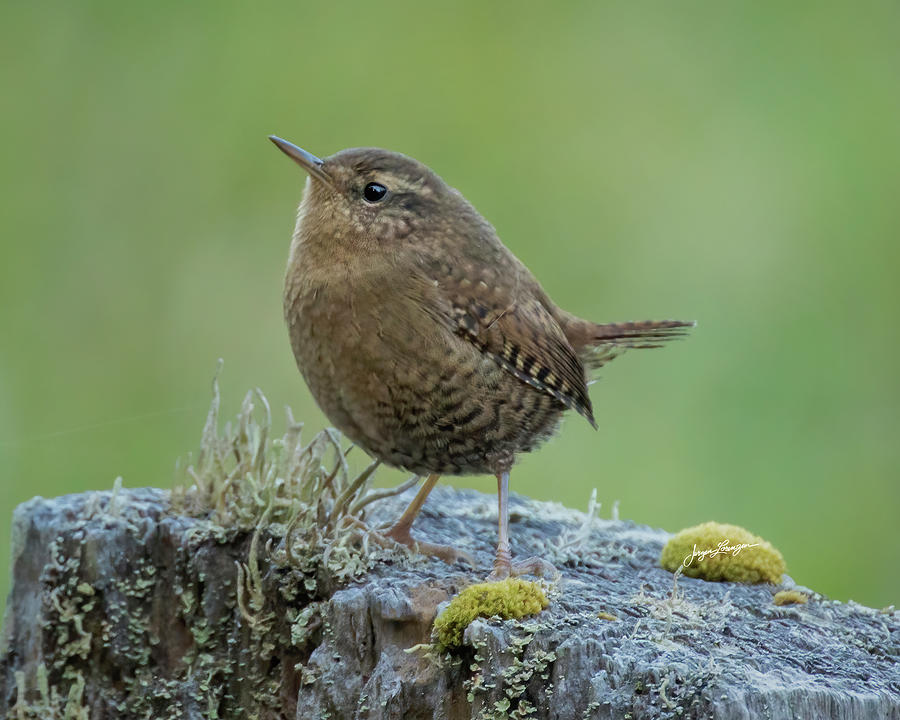
Winter Wrens are not frequently encountered in Colorado, but they are considered regular during the winter in the eastern part of the state.
These wrens have small, plump bodies with brown feathers and darker barring on their wings, tail, and belly. They possess a paler eyebrow stripe and short tails, which they hold upright. Both males and females exhibit similar appearances.
Winter Wrens closely resemble Pacific Wrens, and they were previously considered the same species. However, they are now recognized as distinct species with different songs.
Scientific name: Troglodytes hiemalis
Length: 3.1-4.7 inches (8-12 cm)
Weight: 0.3-0.4 ounces (8-12 g)
Wingspan: 4.7-6.3 inches (12-16 cm)
Winter Wrens are found in eastern United States during the winter and northeastern United States and Canada during the summer.
When searching for Winter Wrens, look within tangled undergrowth in forests and backyards. They feed on insects and spiders by rummaging through fallen leaves and decaying bark.
Winter Wrens produce a long, bubbly, sweet song that is slower than the song of Pacific Wrens, lasting up to 10 seconds.
Nests of Winter Wrens are constructed from twigs, moss, and grass woven together into a round shape with a small opening. The females lay 1-9 eggs, which hatch after approximately two to two and a half weeks. The chicks then take around two to three weeks to fledge.
To attract Winter Wrens to your backyard, consider providing native plants and dense vegetation.
Interesting fact: Winter Wrens build round nests with small openings and sometimes hang them from trees.
7. Carolina Wren
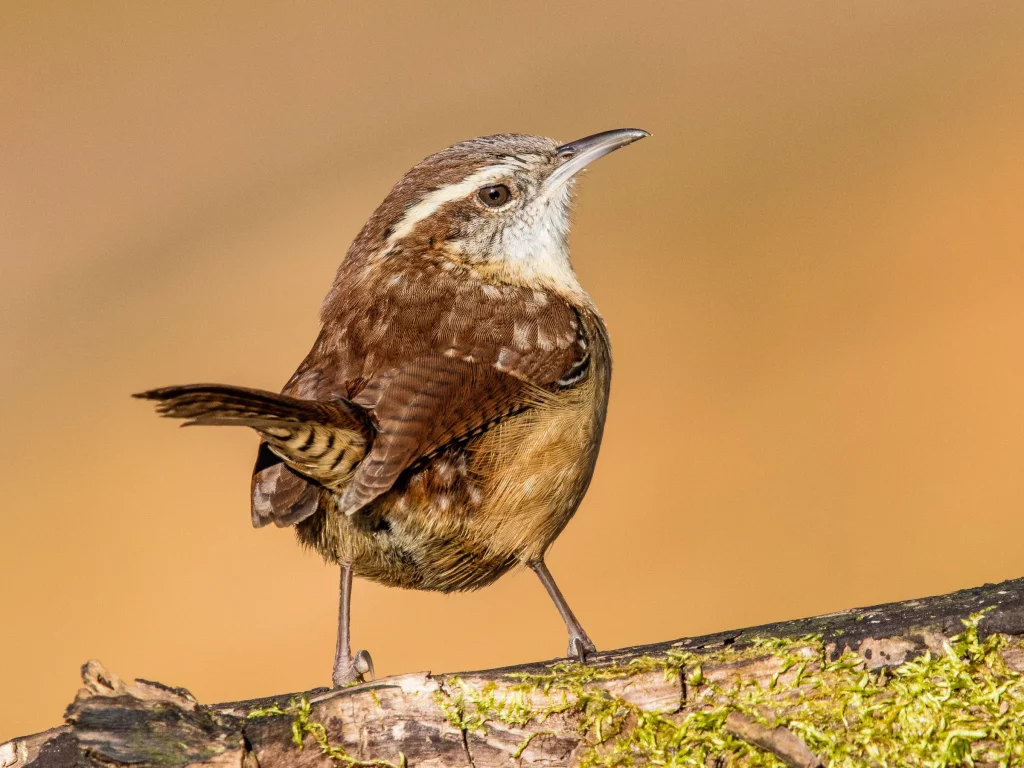
Carolina Wrens are considered accidental species in Colorado. However, records indicate sightings around Lamar in 2022.
Carolina Wrens are shy birds with dark brown upperparts and light brown underparts. They possess a white eyebrow stripe and an upright tail.
Scientific name: Thryothorus ludovicianus
Length: 4.7-5.5 inches (12-14 cm)
Weight: 0.6-0.8 ounces (18-22 g)
Wingspan: 11.4 inches (29 cm)
Carolina Wrens are year-round residents in eastern and southeastern states of the United States.
To find Carolina Wrens, explore wooded areas or regions with dense vegetation. These wrens may visit backyard feeders and primarily feed on insects and spiders. They may occasionally consume lizards, frogs, and snakes.
Carolina Wrens produce a short song consisting of quick whistles.
Nests of Carolina Wrens are usually located in trees but can be built in various natural or artificial locations. The nests are often nearly circular with a small opening on the side. The females lay 3-7 eggs, which hatch after around two weeks, and the chicks fledge after an additional two weeks.
To attract Carolina Wrens to your backyard feeders, consider providing suet feeders, hulled sunflower seeds, or peanut hearts in large tube feeders or platform feeders.
Interesting fact: Carolina Wrens form lifelong pair bonds.
8. Pacific Wren
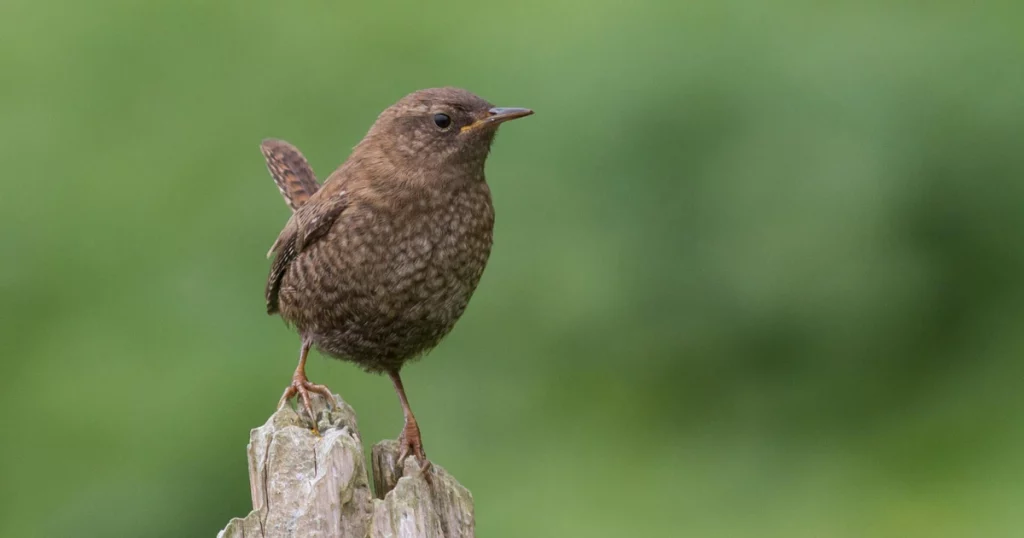
Credit: VJAnderson
Pacific Wrens are rarely observed in Colorado, but they are considered regular and were recently spotted around Pueblo in 2022.
Pacific Wrens have brown plumage with darker barring
on their wings, tail, and belly. They possess a paler eyebrow stripe and short tails, which they hold upright. Males and females exhibit similar appearances.
Distinctive features: They are the smallest wren species in the United States.
Scientific name: Troglodytes pacificus
Length: 3.1-4.7 inches (8-12 cm)
Weight: 0.3-0.4 ounces (8-12 g)
Wingspan: 4.7-6.3 inches (12-16 cm)
Pacific Wrens are found along the West Coast, ranging from Alaska to California. Coastal populations remain year-round, while inland individuals in Canada migrate south for the winter.
To locate Pacific Wrens, search for them on the ground in forests, often hidden within a mass of leaves and decaying logs. They feed on insects, spiders, flies, and bees.
Pacific Wrens produce a long, jumbled song consisting of many different fast, high-pitched notes.
Nests of Pacific Wrens are constructed from twigs, moss, and grass woven together into a round shape with a small opening. The females lay 1-9 eggs, which hatch after approximately two to two and a half weeks. The chicks then take around two to three weeks to fledge.
To attract Pacific Wrens to your backyard, consider providing native plants and dense vegetation. Installing a nest box can also be beneficial.
Interesting fact: Pacific Wrens often huddle together when it’s cold, with multiple individuals sharing the same cavity or nest box. Over 30 individuals have been found together in a single nest box.
9. Sedge Wren

Sedge Wrens are rarely spotted in Colorado, but they were observed around Arapahoe County in 2022.
These small brown wrens have darker upperparts with streaking and barring, and paler underparts. They possess a small light eyebrow stripe. Males and females have similar appearances.
Sedge Wrens resemble Marsh Wrens and are found in similar wet areas. However, Marsh Wrens lack striped shoulders and exhibit lighter bellies.
Scientific name: Cistothorus stellaris
Length: 3.9-4.7 inches (10-12 cm)
Weight: 0.3-0.3 ounces (7-10 g)
Wingspan: 4.7-5.5 inches (12-14 cm)
Sedge Wrens breed in southern Canada, the Midwest, and sometimes further east in the United States. They migrate and spend winters in southeastern states and northern Mexico, particularly near the Gulf and Atlantic coasts.
To find Sedge Wrens, search within wet grasslands, marshy areas, and meadows with dense vegetation. They prefer shallower areas compared to Marsh Wrens and forage for insects and spiders.
Sedge Wrens produce a simple song consisting of a few short notes followed by a similar pitch of a few more rapid notes.
Nests of Sedge Wrens are cup-shaped and built from twigs, grasses, and woven materials. The females lay 2-7 eggs, which hatch after around two and a half weeks. The chicks then fledge after approximately three weeks.
Interesting fact: Sedge Wrens are known to be territorial and may pierce the eggs of neighboring Sedge Wrens, destroying them.
10. Cactus Wren
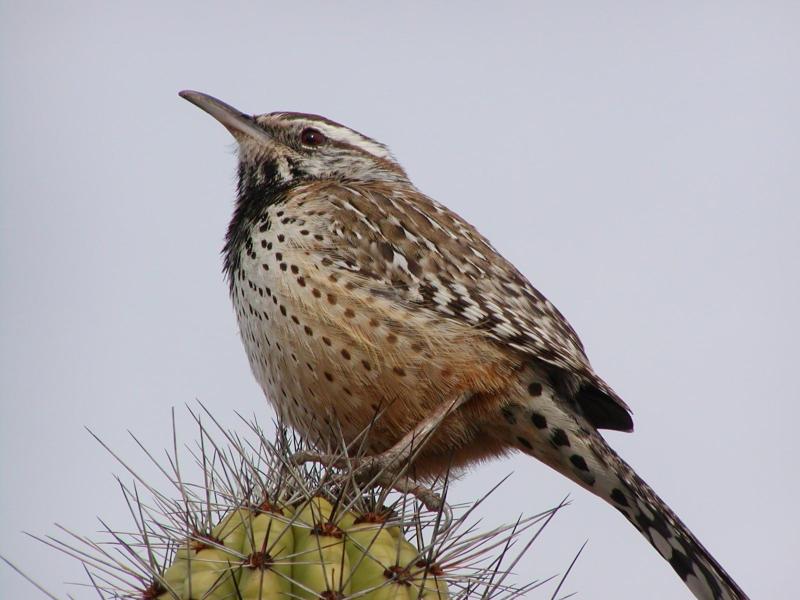
Cactus Wrens are extremely rare in Colorado and were last spotted in the state in 2018.
These wrens are easily recognizable due to their speckled undersides, bold eyebrow stripe, and larger size. They have brown backs with streaks.
Unlike most wrens, Cactus Wrens do not possess an upright tail. Instead, they fan their tails to reveal the white tips.
Scientific name: Campylorhynchus brunneicapillus
Length: 7.1-8.7 inches (18-22 cm)
Weight: 1.1-1.7 ounces (32-47 g)
Cactus Wrens are residents of dry areas in southwestern states, ranging from California to Texas and Mexico.
To locate Cactus Wrens, look for them out in the open at the top of cacti, where they may be singing or feeding on cactus fruits. They can also be observed on the ground, hunting for insects and spiders by turning over leaves and debris.
Cactus Wrens produce a distinctive buzzy two-tone song that often increases in volume as it progresses.
Nests of Cactus Wrens are round-shaped with a small tunnel entrance and are built in desert vegetation. The females lay 2-7 eggs, which hatch after around two and a half weeks. The chicks then fledge after approximately three weeks.
Interesting fact: Cactus Wrens do not need to drink water and obtain all the moisture they need from insects and fruits.
How to Attract Wrens to Your Backyard
Having wrens visit your backyard allows you to enjoy their beautiful songs and observe their energetic behavior. While only a few species of wrens regularly visit backyards, such as House Wrens, Carolina Wrens, and Bewick’s Wrens, you can attract them by following these tips:
1. Create habitats for insects and spiders by leaving fallen leaves and brush piles in your yard.
2. Provide clean water sources, preferably with running water, in multiple locations.
3. Offer suitable nesting sites, such as nest boxes or old boots left out.
4. Provide food sources like mealworms, crickets, peanut pieces, and suet.
5. Plant native vegetation and maintain dense vegetation to create a suitable habitat.
How Frequently Wrens are Spotted in Summer and Winter
Checklists are valuable resources for determining the frequency of bird sightings. The following lists show the most commonly recorded wren species on checklists submitted to eBird in summer and winter:
Wrens in Summer:
1. House Wren – 30.4%
2. Rock Wren – 3.0%
3. Canyon Wren – 1.7%
4. Marsh Wren – 1.5%
5. Bewick’s Wren – 0.8%
6. Carolina Wren – <0.1%
7. Pacific Wren – <0.1%
8. Winter Wren – <0.1%
9. Sedge Wren – <0.1%
Wrens in Winter:
1. Marsh Wren – 0.8%
2. Canyon Wren – 0.8%
3. Bewick’s Wren – 0.5%
4. Winter Wren – 0.3%
5. Rock Wren – 0.2%
6. Carolina Wren – 0.1%
7. Pacific Wren – <0.1%
8. Sedge Wren – <0.1%
9. House Wren – <0.1%
